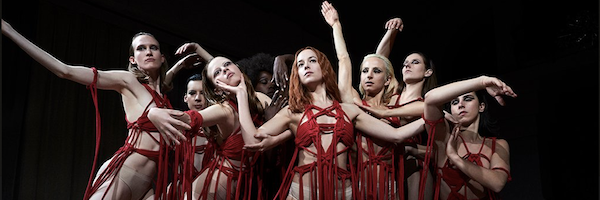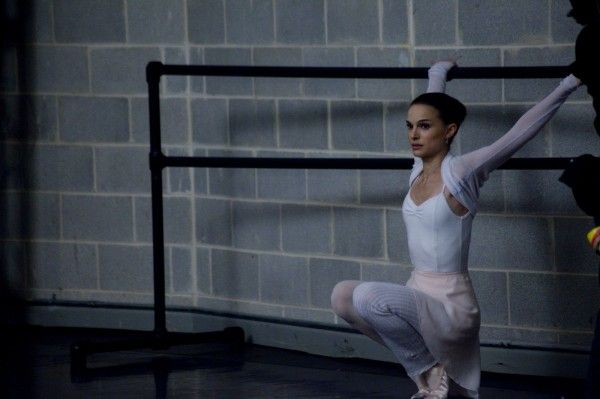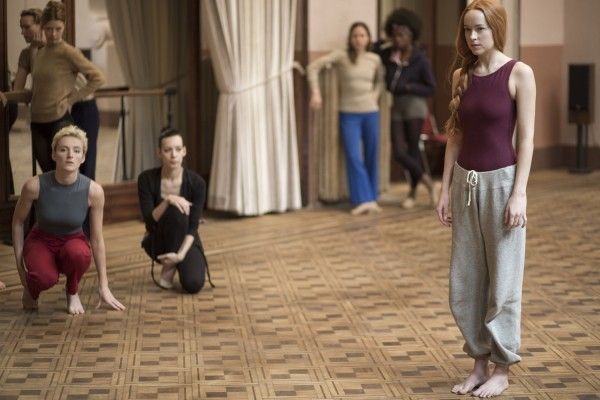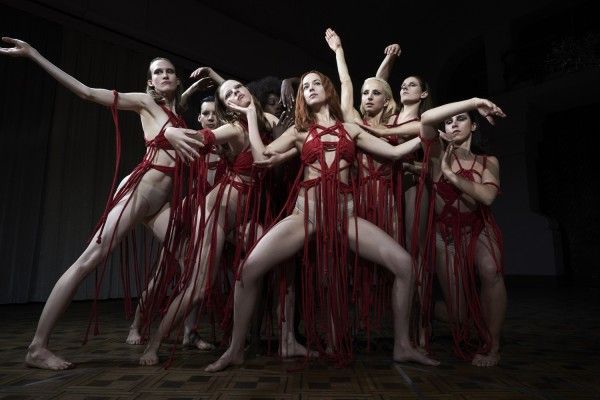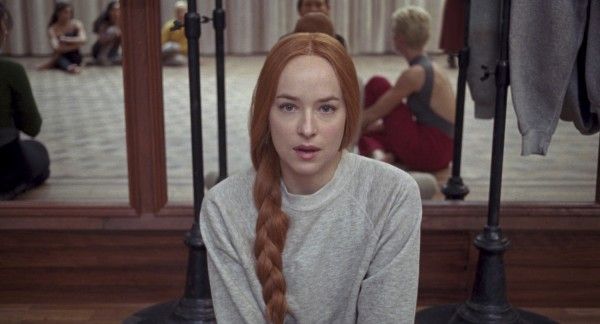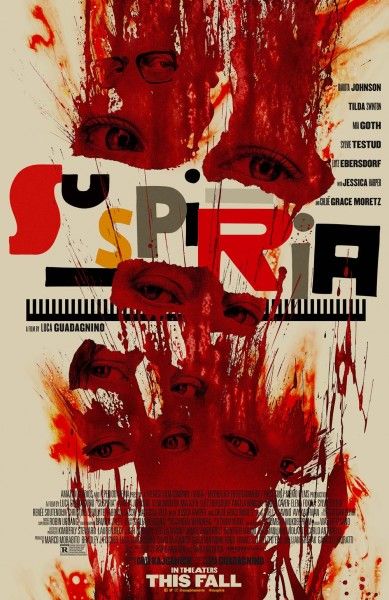Dance is a multi-faceted art form comprised of beauty and pain. Hidden behind its polished surface lies a violent path towards power and perfection. Athleticism, coupled with strength and poise, requires endless hours of training while dancers suppress their appetites for a slender physique, feeding form and technique instead. Then there is the gruesome physicality; broken toenails and blood-filled blisters pressed tightly into battered ballerina slippers. Dancing hides dark histories concerning a sense of sacrifice and the suppression of female bodies. The notion of dance as a dedication, danger, and desire is coupled with a quest for power, preservation, and perfection -- a connection with historical significance that bleeds onto the silver screen, where the use of the female form in dance is tied to its basic primitive purpose: to create, and in Suspiria, to create magic.
The maniacal obsession with dance and vanity in fiction dates as far back as 1845, with Hans Christian Andersen’s fairy tale, The Red Shoes. The story follows an entitled young girl who is gifted a pair of red shoes that require her to dance continuously. Unable to stop, she misses the funeral of her adopted mother and begs an archangel for mercy; but instead, he condemns her to dance into the afterlife as a moral for all conceited children. Exhausted, she finds an executioner to chop off her feet, and yet her red shoes continue to dance even with her amputated extremities inside them. In 1948, a Technicolor-drenched film adaptation directed by Michael Powell and Emeric Pressburger chronicled an ambitious ballerina named Vicky (Moira Shearer), who stars in the production of The Red Shoes ballet. When asked, “Why do you dance?” She simply responds, “Why do you live?”. Vicky’s passion for the art eventually leads to her death, as she becomes torn between her love of dance and her love for a man, consequently choosing to sacrifice herself entirely by plunging over a balcony onto the train tracks below.
Likewise, Darren Aronofsky’s Black Swan explores the dedication to and the sacrificial pursuit of one’s craft. Again, referencing classical ballet, dance student Nina (Natalie Portman) starves to maintain the ideal body image while burning the candle on both ends, working late hours at the company studio to perfect the lead of Swan Lake. In the process, she spirals into madness; dancing around a fractured reality, unable to distinguish what is real and what is an illusion. Haunting mirror images of a doppelgänger, feathers penetrating through her skin, and competition with a deceptive rival dancer all push her to succumb to the perfectionist pressures of the ballet, which simultaneously result in her death and birth as a star. Ballet is considered to be one of the highest art forms and dance, one of the most mesmerizing manners in which the human body is used as an expressive means of beauty. Yet, as the film progresses, the dancing becomes more violent, and Nina eventually destroys her own body--the very vessel that helped her create the only purpose she had in life.
Historically, dancing has not always carried the popular or luxurious qualities it does today. Early opposition to rhythmic movement came primarily from Puritans, who equated the joyful past time with sin and promiscuity. Their European superstitions regarding witchcraft and female oppression were instrumental during the witch persecutions of the 17th century; dance was viewed to be a forbidden pleasure, an act of succumbing to temptation, and therefore associated with the Devil. The female body was considered dangerously seductive, and therefore, women were required to suppress their innate desires. As such, dance came to signify a sense of unity and defiance of overbearing patriarchal oppression. It was (and to this day still is) an escape from convention and guilt that fostered self-confidence, autonomy, and sisterhood -- intimidating concepts to those in power.
In modern-day Wiccan practices, dance is employed as a method of harnessing power and shaping reality. Seasonal festivals, or sabbats, are common for witches to gather and dance in order to raise energy for celebrating birth, death, and rebirth. The connection between ritual and dance takes center stage in Luca Guadagnino’s remake of Suspiria, which amalgamates dance, witchcraft, and sexuality to creatively conquer the stages of life through Susie Bannion’s (Dakota Johnson) character arc and her relation to the coven residing in world-renowned Helena Markos Dance Academy. Guadagnino focuses on the art form as a spellbinding weapon, employing the female body as a catalyst for both creation and destruction while utilizing dance to tell the story of Susie’s journey through birth, death, and rebirth.
Amidst the political unrest occurring outside the academy’s walls, Madame Blanc introduces a new piece about rebirths and “the inevitable pull that they exert and our efforts to escape them.” This magnetism is reflected in Susie’s instinctual pull to Berlin, supported by flashback scenes from her childhood where she daydreams about visiting the alluring location. The same pull is exhibited in her body through dance. In her audition, she exercises long, outward stretches and limber backbends.
Susie’s routine is void of sound, focused entirely on breath and bodywork. Her arms cut quickly into the air with precision as sharp as the hooks that impale her peer’s skin when her dance is done. Jolting and thrusting in animalistic movements reminiscent of expressionist choreographer Mary Wigman, her body becomes supernaturally synchronized with Olga, a classmate who recently resigned from the company. As Susie throws her body, Olga's body is also thrown against her will, violently slamming into the mirrors of an adjoining room and contorting her limbs into a twisted display of gruesome body horror. Susie's dance is a form of dark magic. In Suspiria, the human form is a weapon of witchcraft rather than wands, incantations, or even Dario Argento’s preferred style of black gloves and knives. This progressive take on the craft also juxtaposes Susie’s sexually repressed Mennonite upbringing, where girls are scorned for any sort of unholy use of the female body outside of procreation. Therefore, dance in Suspiria is also a catharsis--a vehicle to drive desire and emit pride in Susie's female form, which is otherwise religiously viewed as heinous or shameful.
Guadagnino’s coven also possesses a collective sisterhood typically missing in film. There's no cruelly competitive nature among the young dancers, and Madame Blanc radiates a rare warmth towards Susie to help develop her craft in a manner reminiscent of traditional coven initiation. She receives individualized instruction and is presented with an opportunity to be an authority by being the lead in the dance and the coven itself. Madame Blanc displays a facetious motherly quality towards Susie, as it is common for an apprentice and their teacher to develop a strong bond. This dynamic foils the three mothers narrative and obscures the common characteristics of an antagonist.
These personal interactions within the studio further reflect aspects of modern witchcraft, as the primary principle of magic is connection. The relationships formed within the coven are crucially weaved together harmoniously and democratically. Like the blood-red costumes wrapped around the girls’ bodies, they serve as a symbol of unity and strength to summon a powerful transformation. With Susie in the center, their performance is an example of casting a circle, which resonates in layers of awakening atop the strategically placed designs drawn on the floor. Energy naturally moves through the group number renewing the individual and revitalizing the girls simultaneously. Their presence is one of integrated vigor as the movements are rapid, razor-sharp, and viciously lyrical. Glaring eyes, sudden slamming onto the floor, bowed heads, and interlaced twirls exude a sense of fervent foreboding and are refreshingly not the stereotypical motions of seduction normally attributed to women dancing--especially those considered to be witches.
The German expressionist choreography exhibited in the film ultimately conveys Susie’s story of birth, death, and rebirth; from her innate pull to Madame Blanc to the climactic blood-splattered finale where she asserts her newfound role in ritualistic style. Freed from sexual repression and moving with gravity to harness the natural rhythms of the coven and turbulent political environment, Susie gives her soul to the dance with a bold fierceness and devilish flare--ultimately creating her own power and self-preservation which, like the female body, are wonderful weapons in their own right.

